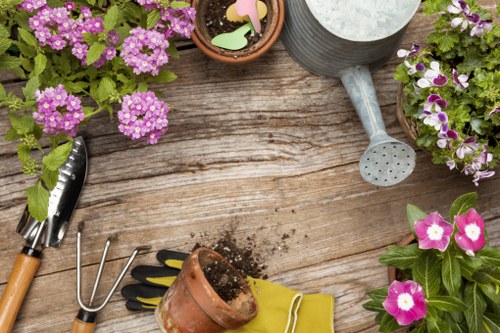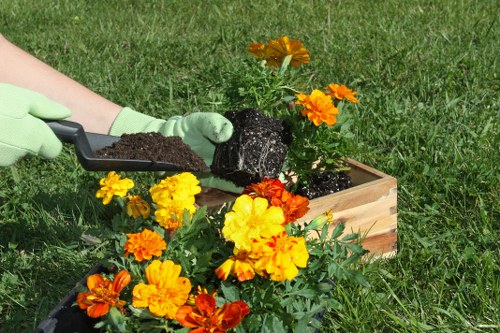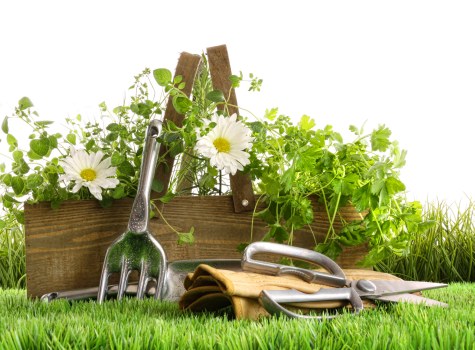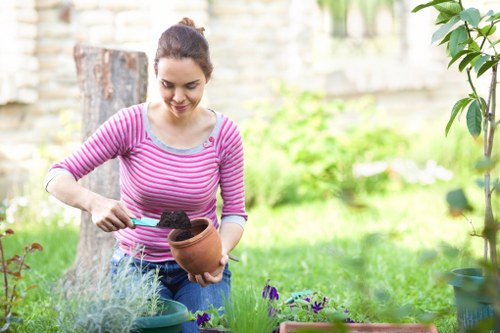Transform Your Outdoor Space: Landscaping in Cricklewood

Introduction to Landscaping in Cricklewood
Cricklewood, located in the heart of North West London, offers a unique blend of urban charm and suburban tranquility. Landscaping in Cricklewood is not just about enhancing the aesthetic appeal of your property; it's about creating a harmonious outdoor environment that reflects your personal style while adapting to the local climate and community.
Whether you're looking to redesign your garden, install a new patio, or create a sustainable green space, understanding the nuances of landscaping in this vibrant area is essential. This guide will explore the various aspects of landscaping in Cricklewood, providing you with the insights needed to transform your outdoor space.
From choosing the right plants to selecting the best materials for your garden structures, landscaping in Cricklewood requires careful planning and consideration. Let's delve into the key elements that make landscaping projects successful in this bustling locality.

Understanding Cricklewood's Climate and Soil
Climate Considerations
Cricklewood experiences a temperate maritime climate, characterized by mild summers and cool winters. Understanding the local climate is crucial for selecting plants and designing landscapes that thrive year-round.
During the summer months, temperatures can reach up to 25°C (77°F), while winters may see temperatures drop to around 5°C (41°F). Adequate drainage and watering systems are essential to manage the seasonal variations and ensure plant health.
Additionally, frequent rainfall throughout the year necessitates the use of resilient plant species and effective irrigation methods to prevent waterlogging and soil erosion.

Soil Composition and Preparation
The soil in Cricklewood varies from clay-heavy to loamy textures, influencing drainage and nutrient availability. Conducting a soil test is recommended to determine pH levels and nutrient content, allowing for appropriate soil amendments.
Improving soil structure with organic matter such as compost or well-rotted manure can enhance fertility and drainage. Raised beds or container gardening may also be beneficial for areas with poor soil conditions.
Proper soil preparation lays the foundation for a successful landscaping project, ensuring that plants have the necessary environment to grow and flourish.

Choosing the Right Plants for Your Cricklewood Garden
Native vs. Non-Native Plants
Selecting plant species that are native to the Cricklewood area can offer several advantages, including better adaptability to local climate conditions, reduced maintenance, and support for local wildlife.
- Advantages of Native Plants: Lower water requirements, resistance to local pests, and minimal need for fertilizers or pesticides.
- Non-Native Plants: While they can add unique aesthetic value, they may require more care and maintenance to thrive.
Balancing native and non-native plants can create a diverse and resilient garden that benefits both the homeowner and the environment.
Popular Plant Choices
Popular plants for Cricklewood gardens include:
- Lavender – Known for its fragrance and resilience.
- Boxwood – Ideal for creating structured hedges and borders.
- Hostas – Perfect for shaded areas, offering lush foliage.
- Roses – A classic choice for vibrant blooms and romantic appeal.

Designing Your Landscape: Key Elements
Hardscaping Features
Incorporating hardscaping elements such as patios, pathways, and fences can add functionality and structure to your garden. Materials commonly used in Cricklewood include:
- Stone: Offers durability and a natural look.
- Brick: Provides a classic aesthetic and versatility.
- Wood: Ideal for pergolas, decking, and garden structures.
Choosing the right materials ensures that your hardscaping features complement the overall design and withstand the local weather conditions.
Softscaping Elements
Softscaping involves the use of plants, trees, and flowers to create a visually appealing and sustainable landscape. Key considerations include:
- Plant Placement: Strategically placing plants to create depth, contrast, and focal points.
- Color Schemes: Selecting colors that harmonize with each other and the surrounding architecture.
- Texture and Form: Combining different textures and shapes to add interest and variety to your garden.
Effective softscaping enhances the beauty and functionality of your outdoor space, making it a welcoming area for relaxation and entertainment.

Sustainable Landscaping Practices
Water Conservation
Implementing water-efficient practices is essential for sustainable landscaping in Cricklewood. Techniques include:
- Drip Irrigation: Delivers water directly to plant roots, minimizing waste.
- Rainwater Harvesting: Collecting and storing rainwater for garden use.
- Mulching: Reduces evaporation and maintains soil moisture.
By conserving water, you not only save on utility bills but also contribute to environmental sustainability.
Using Native and Drought-Resistant Plants
Choosing plants that are adapted to the local climate reduces the need for excessive watering and maintenance. Drought-resistant varieties are particularly beneficial in promoting a low-maintenance garden.
Incorporating native species supports local biodiversity, providing habitats for pollinators and other wildlife.

Professional Landscaping Services in Cricklewood
Why Hire a Professional?
Engaging professional landscaping services ensures that your project is executed efficiently and to the highest standards. Professionals bring expertise in design, plant selection, and maintenance, helping you achieve your vision with ease.
- Expert Advice: Professionals can provide valuable insights and recommendations tailored to your specific needs.
- Time-Saving: Hiring experts allows you to focus on other priorities while they handle the project.
- Quality Results: Experienced landscapers deliver aesthetically pleasing and durable outcomes.
Choosing the Right Landscaping Company
When selecting a landscaping company in Cricklewood, consider the following factors:
- Portfolio: Review previous projects to assess the company's style and quality.
- Reviews and Testimonials: Look for positive feedback from past clients.
- Services Offered: Ensure the company provides the specific services you require.
- Pricing: Obtain detailed quotes and compare pricing to find value for money.
Choosing the right professional can make a significant difference in the success of your landscaping project.

Maintenance Tips for Your Cricklewood Garden
Regular Care and Upkeep
Maintaining a beautiful garden requires consistent care. Regular tasks include:
- Pruning: Trimming plants and trees to promote healthy growth and shape.
- Weeding: Removing unwanted plants to reduce competition for resources.
- Fertilizing: Providing essential nutrients to support plant vitality.
Seasonal Maintenance
Adapting your maintenance routine to the seasons helps ensure year-round garden health:
- Spring: Planting new flowers, preparing garden beds, and fertilizing soil.
- Summer: Watering regularly, deadheading flowers, and managing pests.
- Autumn: Raking leaves, planting bulbs for spring, and protecting plants from frost.
- Winter: Pruning bare trees, applying mulch, and planning next year's garden.
Seasonal maintenance keeps your garden thriving and looking its best throughout the year.

Enhancing Your Garden with Features
Water Features
Adding a water feature, such as a fountain or pond, can create a serene atmosphere and attract wildlife. Benefits include:
- Visual Appeal: Water features serve as focal points, enhancing the overall design.
- Sound: The gentle sound of water adds a calming element to your garden.
- Wildlife Attraction: Ponds and fountains provide habitats for birds and beneficial insects.
Lighting Solutions
Proper lighting extends the usability of your garden into the evening hours and highlights key features:
- Pathway Lighting: Ensures safe navigation through your garden at night.
- Accent Lighting: Highlights architectural features, plants, or sculptures.
- Ambient Lighting: Creates a warm and inviting atmosphere for outdoor gatherings.
Integrating lighting thoughtfully can transform your garden into a magical nighttime retreat.

Eco-Friendly Landscaping Practices
Composting
Composting garden waste reduces landfill usage and creates nutrient-rich soil amendments. Benefits include:
- Soil Enrichment: Compost improves soil structure and fertility.
- Waste Reduction: Minimizes the amount of organic waste sent to landfills.
- Sustainable Gardening: Encourages a closed-loop system of recycling garden materials.
Organic Gardening
Using organic methods reduces the reliance on chemical fertilizers and pesticides, promoting a healthier environment:
- Natural Pest Control: Utilizing beneficial insects and organic repellents.
- Organic Fertilizers: Enhancing plant growth with natural nutrient sources.
- Soil Health: Maintaining balanced soil ecosystems through organic practices.
Eco-friendly practices not only benefit your garden but also contribute to the broader environmental health of Cricklewood.

Creative Landscaping Ideas for Cricklewood
Vertical Gardens
Vertical gardening maximizes space, especially in urban settings like Cricklewood. It involves growing plants on walls, fences, or specially designed structures:
- Space Efficiency: Ideal for small gardens or balconies.
- Aesthetic Appeal: Adds greenery and visual interest to vertical surfaces.
- Air Quality: Plants help purify the air, enhancing the overall environment.
Edible Gardens
Incorporating edible plants into your landscape combines beauty with functionality. Benefits include:
- Fresh Produce: Enjoy homegrown vegetables, herbs, and fruits.
- Educational Value: Teaches sustainable practices and gardening skills.
- Health Benefits: Encourages outdoor activity and healthy eating.
Edible gardens can be both practical and aesthetically pleasing, offering a rewarding gardening experience.

Budget-Friendly Landscaping Tips
DIY Projects
Embarking on DIY landscaping projects can significantly reduce costs while allowing for personalization:
- Pathways: Create attractive paths using gravel, stepping stones, or reclaimed materials.
- Planters: Repurpose containers or build your own planters for a unique touch.
- Mulching: Apply mulch to suppress weeds and retain moisture, enhancing garden health.
Reusing Materials
Utilizing recycled or repurposed materials contributes to sustainability and budget management:
- Reclaimed Wood: Use for garden benches, fences, or decorative features.
- Repurposed Containers: Transform old pallets, barrels, or other items into creative planters.
- Natural Stones: Incorporate stones from local sources for a rustic look.
Creative reusing of materials can enhance your garden's uniqueness while keeping expenses low.

Conclusion: Achieving Your Dream Garden in Cricklewood
Landscaping in Cricklewood offers endless possibilities to create a beautiful, functional, and sustainable outdoor space. By understanding the local climate, selecting appropriate plants, and incorporating key design elements, you can transform your garden into a personal sanctuary.
Whether you choose to undertake the project yourself or hire professional services, careful planning and thoughtful execution are essential for success. Embrace the vibrant community and rich environment of Cricklewood to inspire your landscaping journey.
Contact us today to start creating the garden of your dreams in Cricklewood!